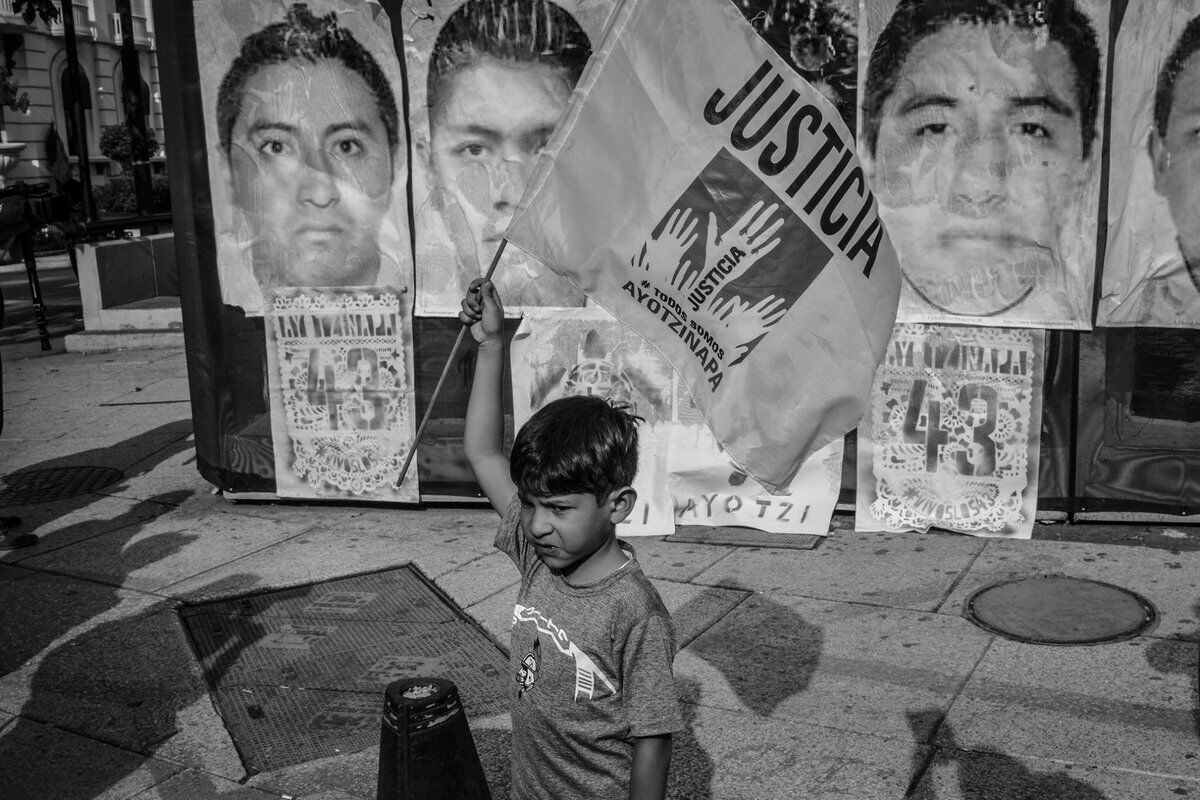In Gore Capitalism, transfeminist intellectual Sayak Valencia gives us a vocabulary, a taxonomy to articulate a horror that before 2010 we did not have words to name in Mexico. We had the numbers, the statistics, the hard, cold data to understand the economics and the politics. What we did not have was the key that would help us make sense of the images that began to appear in the most common, quotidian familiar spaces: decapitated heads rolling on the floor of a discotheque, a body hanging from a bridge outside a mall, black plastic bags full of dismembered corpses being transported on the backs of trucks on the highway, like the bag that fell in front of Valencia’s car one day in Tijuana and that launched her in to writing this book. To make sense. To provide a vocabulary that could help reveal the system at work that was hiding behind the horror.
The ideas proposed by Valencia are still relevant today, on the fifth anniversary of the killing of forty-three indigenous and peasant students from Ayotzinapa, an atrocity that involved the state and drug cartels and that speaks of contemporary forms of governmentality in Mexico. Her ideas are also indispensable as the number of killings, including femicides, increases in the country.
Valencia’s work speaks to the systemic violence that is so pervasive across Mexico, because although the book predates it, she predicts it. Nine years ago, Valencia described the borders of the country as the sacrificial zones of the nation, where violence was concentrated. Now the whole country has become a sacrificial zone. In uncountable mass graves, the Mexican soil is swallowing the victims of gore capitalism.
Valencia builds her work from the perspective of transfeminism and draws from the theoretical and methodological genealogy of feminists of color. Writing from embodied, lived experience and through different registers mixing scholarship, poetry, and essay, she reveals dimensions of the problem of violence that previous approaches did not, particularly the role of hyper-masculinity and hyper-consumption in the frame of neoliberal precarization.
She provides a cultural understanding of violence as a systemic problem that is the result of a triangulation among the political oligarchy, the narco-machine, and the neoliberal necro-economy. This structure is reinforced with the values of heteropatriarchal masculinity under the demands of excessive consumption imposed by capitalism.
Drawing on the cinematic genre, Valencia coins the term gore capitalism to illustrate how, in this system, radical violence becomes a form of entrepreneurial labor for precarious men for whom the capitalization of death achieves social status and power–necro-empowerment. Valencia provides a taxonomy of these practices of extreme cruelty. This is a combination that engenders the mediatized marketing and aestheticization of violence and produces reality in terms of the commercialization of the labor of manufacturing spectacular violence and death as a commodity.
In this way, Valencia reveals the inner workings of gore capitalism and provides an understanding of the phenomenon of violence not in the abstract, but from an embodied perspective–whose head is rolling and why.
Despite this wasteland-like scenario in which landscapes shaped by practices of community have turned into sites of social erosion, Valencia reminds us of our place and responsibility as participants in a civil society who can exert our agency to resist the neoliberal culture of gore capitalism by explicitly disobeying its grammar. Civil society can be a site for the creation of hope through resistance as a means of social transformation.
Even though Valencia uses Tijuana for her fieldwork–and Tijuana is a very personal field that she knows all too well because she inhabits it–gore capitalism is not a phenomenon that is exclusively Mexican. Gore capitalism is not even a problem that is exclusive to the “Third World.”
What does it mean, then, for Valencia’s ideas to “cross the border” by being translated into English?
Having an English edition of Gore Capitalism is an invitation that can be understood as a crossing-over, an exercise in cuir-ing theory from the South, in lengua mestiza, in Tijuanense. It goes beyond merely aligning with the canonical narratives of Latin America according to the hegemonic academic production from centers of power, and it re-situates this thinking from mestiza theory. Thus, it is an invitation to decolonize the curriculum.
In this sense, gore capitalism theory is an exercise in decolonial border thinking. Valencia’s work refuses to locate the “Third World” (a term she chooses to continue to use critically) as the place to outsource the ethnographic data production that would otherwise be submitted to the theoretical filters of northern theory.
Conversely, Valencia theorizes from the South a problematic that is global: the landscapes of predatory contemporary capitalism, particularly in scenarios of neoliberal violence, can be seen across the world wherever populations obey and thereby collude, or choose to resist and disobey, in neoliberal regimes.
In 2018, some examples of the workings of gore capitalism are clearly evident in the police brutality targeted at black people in the US, in the Israeli occupation of Palestine, in the Syrian conflict, in the xenophobia against immigrants, in the proliferation of femicide and transfemicide, in the criminalization of racialized poverty, and in the dispossession of indigenous lands across the world.
Nine years after Valencia gave us the words to name the horrors of gore capitalism, today, another grammar has emerged as a sort of B side to the violence that is engulfing Mexico and other latitudes.
This disobedient grammar articulates how civil society is occupying the public space and the virtual sphere to claim #FueElEstado (It Was the State), #NiUnaMenos (Not one Wom*n Less), #BlackLivesMatter, #FreePalestine, #refugeeswelcome, and #banfracking, amongst others.
These vital slogans are being embodied in marches around the world and mobilized in the virtual one, to contest the increasingly gruesome specter of gore capitalism with the insubordinate spirit of social justice.


